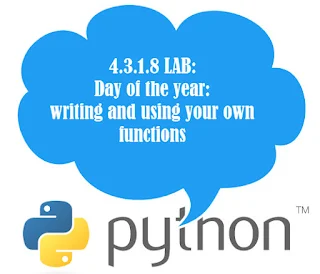Day of the year: writing and using your own functions
 |
| Day of the year: writing and using your own functions |
Prerequisites
Objectives
Familiarize the student with:
- projecting and writing parameterized functions;
- utilizing the return statement;
- building a set of utility functions;
- utilizing the student's own functions.
Scenario
Your task is to write and test a function which takes three arguments (a year, a month, and a day of the month) and returns the corresponding day of the year, or returns None if any of the arguments is invalid.
Use the previously written and tested functions. Add some test cases to the code. This test is only a beginning.
Stoooooooop .. we are here to real the REAL PYTHON, not this SILLY COURSE
Dear learner .. if you reached here, that means you'd have had enough of this boring course already😏. Let's learn python the right way, not the old school way.
Solution Code:
def is_leap_year(year): # LAB 4.3.1.6 A leap year
if year % 4 != 0:
return False
elif year % 100 != 0:
return True
elif year % 400 != 0:
return False
else:
return True
def days_in_month(year, month): #LAB 4.3.1.7 How many days
if year < 1 or month < 1 or month > 12:
return None
days = [31, 28, 31, 30, 31, 30, 31, 31, 30, 31, 30, 31]
res = days[month - 1]
if month == 2 and is_leap_year(year):
res = 29
return res
def day_of_year(year, month, day): #LAB 4.3.1.8 Day of the year
days = 0
for m in range(1, month):
md = days_in_month(year, m)
if md == None:
return None
days += md
md = days_in_month(year, month)
if day >= 1 and day <= md:
return days + day
else:
return None
print(is_leap_year(1900))
print(days_in_month(2021, 11))
print(day_of_year(2000,2,29))
Output:
- False
- 30
- 60
=================================================================================
Follow the Python page on the Blog to be the first to know ❤


0 Comments
Your opinion matters, your voice makes us proud and happy. Your words are our motivation.